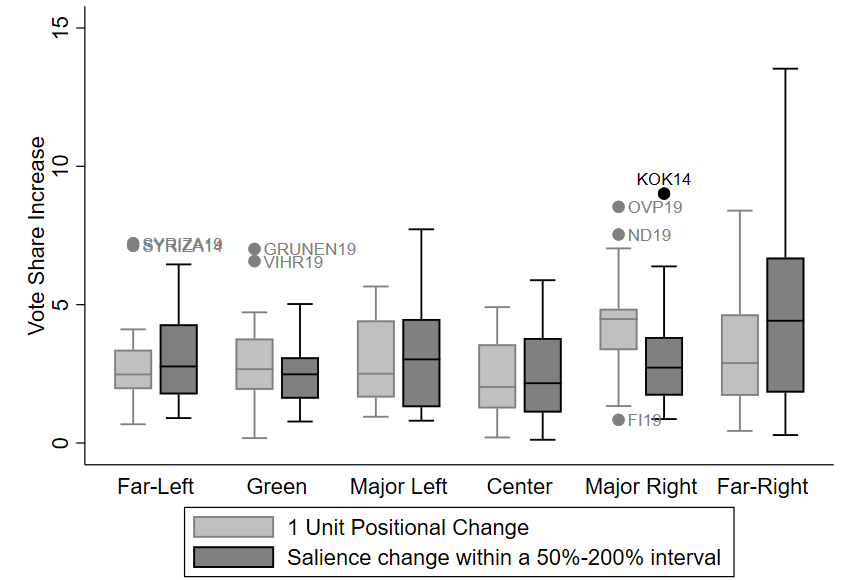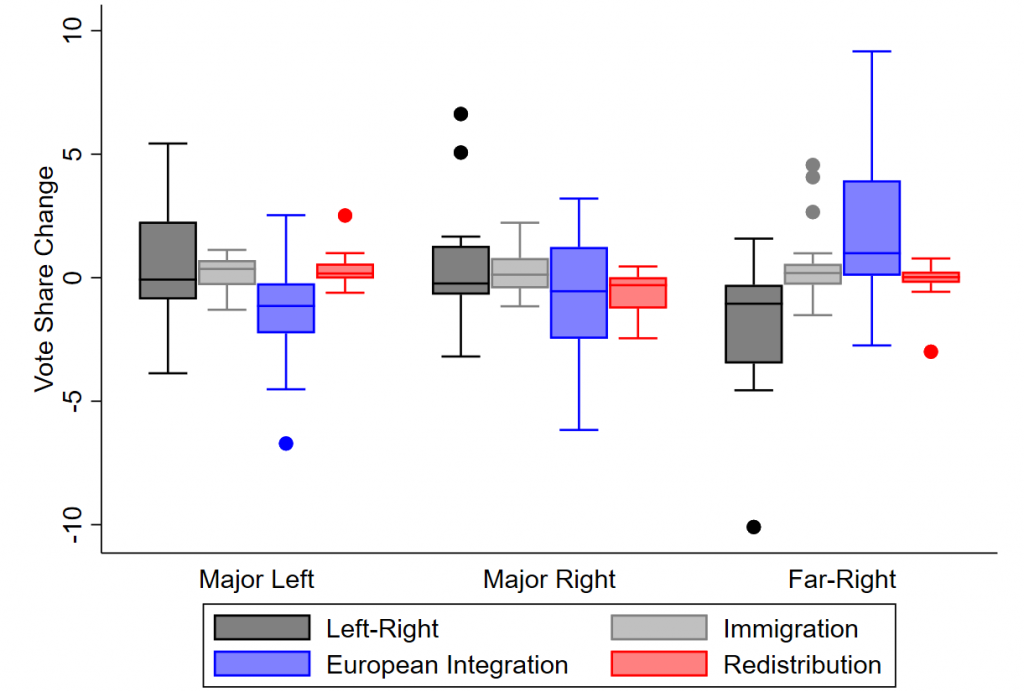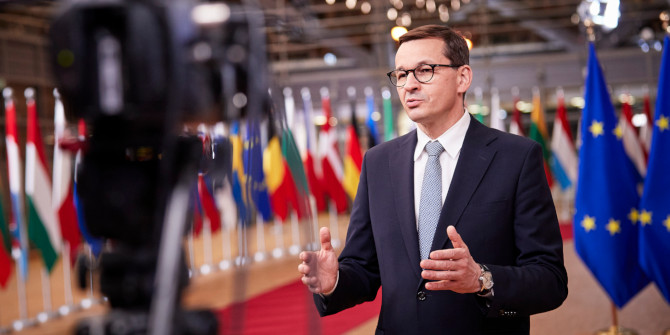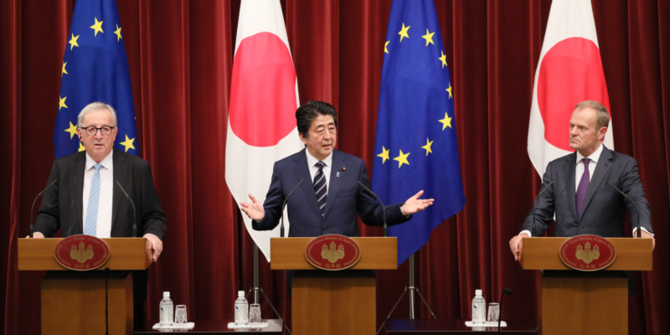Immigration is often portrayed as the most important issue for far-right parties in western Europe. But is this really the case? Drawing on new research, Sofia Vasilopoulou and Roi Zur show the issue that matters most for far-right success is not immigration, but European integration.
The link between immigration attitudes and support for the far-right is well-documented in the academic literature. Indeed, focusing electoral campaigns on immigration helps the far right galvanise support among their core anti-immigrant constituency.
Yet, electoral competition presents a dilemma to these parties: if they moderate their immigration policy, they are likely to be punished by their traditional anti-immigrant electorate. However, if they continue their focus on extreme anti-immigrant positions, they satisfy their core voting base, but risk alienating potential new voters.
Nonetheless, far-right parties have steadily grown in the past decades across western Europe. In a recent study, we find that changes in the public salience of policy issues offers far-right parties a comparative advantage. Specifically, far-right parties’ vote shares are expected to increase when the issue of European integration is salient for voters.
Far-right party competition in western Europe
Data on parties’ policy positions (for example, the Chapel Hill Expert Survey) show that far-right parties take extreme positions on the general left-right ideology dimension, immigration, and European integration, but not on economic redistribution. On immigration, all far-right parties are perceived as extreme (above 8.5 on 0-10 scale), while on EU integration some of these parties are more diverse and less extreme.
These data also show that the main competition to far-right parties on immigration are the major right-wing parties (usually reliable and popular parties), but on the issue of EU integration, only far-left parties (mostly weak and small parties) are competing with the far right for Eurosceptic votes. Thus, the ideological space in western Europe creates larger vote-recruiting potential when EU integration salience is high.
Far-right parties’ extreme positions, especially on immigration, limit their ability to recruit voters by changing their policy platforms. Considering there is limited scope for becoming more extreme, moderation is their only feasible positional change. Yet, research has shown that moderate voters do not tend to vote for extreme parties, even when they moderate their positions. Therefore, the strategic option far-right parties are left with is to try to shift voter attention toward the issue on which they do not encounter serious competition – that is, EU integration.
Position versus salience and far-right party success
In our empirical analyses, we establish the relative importance of parties’ positions and issue salience on the four dimensions – left-right ideology, economic redistribution, immigration, and European integration – using statistical methods. Then we use mathematical simulations to show that changes in the public salience of policy issues can increase the vote share of far-right parties more than changes in far-right parties’ policy positions.
Figure 1 shows how parties’ expected vote shares change when (1) the public salience of issue dimensions changes (in black), and (2) when parties shift their policy positions (in grey). While, overall, parties can make comparable gains in both scenarios, far-right parties can gain (on average) an additional 4.67 percent of the vote due to changes in public issue salience, but only 3.34 percent by changing their own policy positions. On average, the electoral outcomes of far-right parties improve more than any other group of parties when the public salience of different issues changes.
Figure 1: Electoral gains from hypothetical changes in parties’ positions and public issue salience
Note: Boxes show 25th to 75th percentiles of parties’ expected vote share increase under two counterfactual scenarios. Light-grey boxes show vote share increase for four-dimensional positional (as coded by the CHES) change within a one-unit interval. Black boxes show vote share increases for four-dimensional changes in public issue salience within half and twice of the observed salience interval.
The electoral consequences of European integration
After establishing that changes in issue salience are more important for far-right parties’ electoral success than changing their issue positions, we ask which issue(s) are the most important for the far-right’s success. To answer this question, we look at the changes in parties’ expected vote share when one dimension becomes more salient, while the salience of the other three dimensions remains in their observed value.
Figure 2 demonstrates changes in parties’ expected vote share when the salience of a focal dimension doubles (relative to the salience we estimated in our statistical models). These results show that doubling the salience of EU integration is associated with larger vote shares for far-right parties significantly more than doubling the salience of any other dimension.
On average, doubling the public salience of EU integration increases far-right parties’ vote share by over 1.91 percentage points. Doubling the public salience of immigration increases the vote share of far-right parties by only 0.34 percent, while doubling the public salience of redistribution or the general left-right dimension decreases the vote share of far-right parties. These results emphasise the increasing importance of anti-EU rhetoric by far-right parties, especially relative to their anti-immigration rhetoric.
A second way the results in Figure 2 support our argument is that doubling the public salience of EU integration increases far-right parties’ vote share at the expense of pro-EU parties. Both major-left and major-right parties are expected to lose votes when the salience of EU integration increases.
Figure 2: Changes in parties’ expected vote share when public issue salience is doubled
Note: Boxes show 25th to 75th percentiles of parties’ expected vote share change when the public salience of the focal dimensions is doubled.
What are the implications of our findings?
Our analyses show that the far-right in western Europe has a large competitive advantage on the issue of EU integration: almost all major parties are pro-EU and only a handful of small far-left parties are slightly Eurosceptic. We know there is a significant demand for anti-EU positions from voters. On immigration, the far-right enjoys a smaller advantage because many major right-wing parties support restrictive immigration and thus limit the far-right’s product differentiation.
Our findings go some way to explaining how the far-right has been able to expand its support beyond its core anti-immigrant voting base. While we do not dispute that these parties benefit electorally from the immigration issue, we have shown there is ample room to compete based on an additional dimension, which optimises their support.
These results have important implications for parties’ electoral strategies with regards to both position-taking and issue emphasis. Because research has demonstrated that centre-right and centrist parties’ move towards the far right on the issue of EU integration increases its salience and decreases centre-right and centrist parties’ vote share, we can conclude that both shifting right and emphasising EU integration is not a recommended strategy for mainstream parties, assuming their goal is vote-maximisation.
For more information, see the authors’ accompanying paper in Political Behavior
Note: This article gives the views of the authors, not the position of EUROPP – European Politics and Policy or the London School of Economics. Featured image credit: CC-BY-4.0: © European Union 2020 – Source: EP






